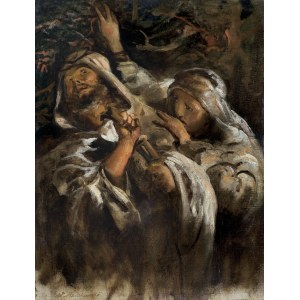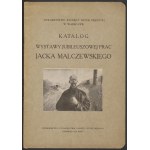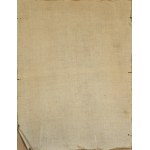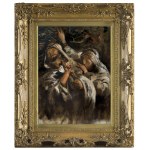40,0 x 30,8 cm - oil, canvas pasted on plywood St. PIOTR WITH ST. JANUARY - STUDY FOR THE IMAGE OF JUDAS'S PACIFICATION, 1879
oil, canvas pasted on plywood, 40 x 30.8 cm
signed l.d.: 79 J. Malczewski
Accompanying the painting is an opinion by Lija Skalska-Miecik and a statement of provenance.
Against a background of greenery, standing figure of the Savior, visible up to his knees, wearing a white cloak. Judas, wearing a blue robe and white veil, approaches him, touching the Savior's right shoulder with his left hand. In the depth on the right St. Peter, wearing a white veil, hides a steel-blue sword in its scabbard; According to St. John 18:11: "Put your sword in its scabbard," wrote Jan Bołoz Antoniewicz about The Kiss of Judas, presented at the Exhibition of One Hundred Works by Jacek Malczewski, held in Lviv in 1903. The author goes on to mention the work to which the exhibited Kiss was a sketch: The painting itself of more considerable size, multiplied by two more figures of the apostles, St. John with an expression of deep sorrow and St. James looking out of the thicket, was exhibited in Cracow between July 1, 1880 and June 1, 1881; purchased for drawing, it is now in the province.
Exhibited in Lviv, the study (oil, cardboard, 29 x 37 cm), created in the winter of 1879/1880 in a studio on Lubicz Street in Krakow, was donated by the artist to Dr. Konstanty Górski in 1880. Both the study from Górski's collection and the work on display in Krakow - are today considered lost. Hence, the offered study depicting the apostles is a very valuable example of Malczewski's work from a particular moment in his artistic biography.
The turn of the 1870s and 1880s is an exceptional time in the artist's life. In June 1879, the artist leaves the School of Fine Arts in Cracow. In the fall of that year, he becomes engaged to Wanda Karczewska, but her father brings about their breakup. Conflicted with his master, Jan Matejko, betrayed by his beloved, who quickly forgot him - the young artist decides to start an independent life in Krakow. He tries to become financially independent of his father, which is not easy; he repeatedly changes apartments and studios. Art critics, on the other hand, are unlikely to favor him. Sad but hopeful, he decided to put his world in order through inner concentration, and declared a move away from society. He reported to his parents about postponing a trip to Italy and obtaining money for this purpose thanks to a Sobanski scholarship, writes Dorota Kudelska (dz. cit., p. 100).
In this difficult period the young painter is supported by friends. They also give encouragement to Julian Malczewski, who always believed in his son's talent, but also had moments of doubt during this difficult time: And in his recent works, do you know progress, do you know something higher than commonness? How does the Kiss of Judas compare? - he asked in a letter to Florian Cynk (dz. cit., p. 105). This question was answered by Hubal-Dobrzanski, who wrote to him in July 1880: Jacek has a painting to complete, which will bring him to the attention of serious critics - The Kiss of Judas, for which you know the sketch, by the way Cynk supposedly wrote to you about it (dz. cit., p. 106). And in subsequent correspondence he reported: In about six months he will finish it and send the painting at once to Vienna, because there reasonable and impartial criticism (dz. cit., p. 107).
The painting was exhibited in Warsaw at the Krywult Salon, and later in Cracow. Criticism in the person of Henryk Struve turned out to be less enthusiastic for the young artist than the words of a friend (Górski himself also considered his study to be a better work than the elaborate composition). On the other hand, the exhibited painting quickly found a buyer, while with the funds from its sale and a loan the artist left with Marceli Czartoryski in June 1880 for a planned trip to Italy.
Both the study from Górski's collection and St. Peter with St. John bear the hallmarks of the young Malczewski's style, shaped in Jan Matejko's studio. These works also betray a certain affinity with the paintings of Matejko's other outstanding pupil, Maurycy Gottlieb. The young painters became friends in 1878, and Dorota Kudelska writes about their relationship: A separate place, an extremely important place [...] occupies in the biography of the author of On the Stage contact with Maurycy Gottlieb during his studies at the SSP. Malczewski probably began painting the first sketches for The Kiss of Judas at that time, so probably the artists sometimes talked about the Bible and ways of depicting its essential contents, but they also shared a passion for poetry. Malczewski was full of admiration not only for Gottlieb's talent, but also for his inner sensitivity, which the artist did not manage to express in his works, and, according to the record of Dr. Rudolf Beres, he was also among those who resented the Jewish community for underestimating the scale of the talent of the author of Ahasver (D. Kudelska, op. cit., pp. 699-670).
Literature:
- Jan Bołoz Antoniewicz, Catalogue of an exhibition of one hundred works by Jacek Malczewski, Lvov, IV-V 1903, cat. no. 9;
- Catalog of the exhibition of paintings by Jacek Malczewski in the building of the TZSP in the Kingdom of Poland, Warsaw 1903, cat. item 3;
- Reproductions of Jacek Malczewski's painting Judas' Kiss, photographs, 1910-1920, National Museum in Cracow, inv. no. MNKXX-f-7927, MNKXX-f-7928;
- Catalog of the Jubilee Exhibition of the Works of Jacek Malczewski, TZSP Publishing House, Warsaw, June 1925, cat. no. 30;
- Dorota Kudelska, Dukt pisma i pędzla. The intellectual biography of Jacek Malczewski, Wydawnictwo KUL, Lublin, 2008;
- Małgorzata Jarczewska-Podejma, Artistic links between Konstanty Maria Górski and Jacek Malczewski, "Kwartalnik Opolski" 2019, 2/3, pp. 136-150.
Jacek Malczewski (Radom 1854 - Cracow 1929) - a prominent representative of Polish modernism painting, began his artistic studies at the School of Fine Arts in Cracow, where in 1872-1875 he studied under Feliks Szynalewski, Władysław Łuszczkiewicz and Jan Matejko, whose studio he attended again in 1877-1879. Then he studied at the Paris École des Beaux Arts under E. Lehmann (1876-1877).
In 1880, he traveled to Italy. In 1884-1885, he took part - as a draughtsman - in Karol Lanckoroński's scientific expedition to Pamphylia and Pisidia in Little Asia. At that time he was also in Greece and Italy. In 1885-1886 he stayed in Munich for several months. Upon his return, he settled permanently in Cracow, from where he made further trips to Munich and Italy. In 1896-1900 he taught at the Cracow School of Fine Arts, and from 1911-1922 he was a professor and twice rector of the Cracow Academy. He spent the years 1914-1915 in Vienna and returned to Krakow in 1916. In the last years of his life he stayed mainly in Luslawice and Charzewice near Zakliczyn. He was a co-founder of the Society of Polish Artists "Art" (1897) and a member of the "Zero" group (1908).
In the early period of his career, he painted portraits, genre scenes and - above all - paintings with themes related to the martyrdom of Poles after the January Uprising (Death of Ellenai, Sunday in the Mine, On the Stage, Christmas Eve in Siberia). Later, from the 1890s, he created paintings with symbolic content with intermingled patriotic, biblical, fairy-tale, literary and allegorical-fantastic themes.
Recently viewed
Please log in to see lots list
Favourites
Please log in to see lots list














